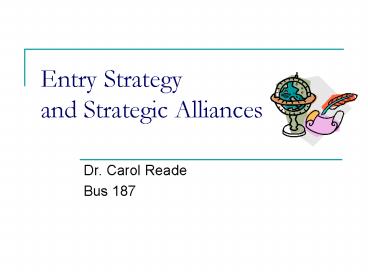Entry Strategy and Strategic Alliances PowerPoint PPT Presentation
1 / 15
Title: Entry Strategy and Strategic Alliances
1
Entry Strategy and Strategic Alliances
- Dr. Carol Reade
- Bus 187
2
Introduction
- Firms expanding internationally must decide
- which markets to enter
- when to enter them and on what scale
- which entry mode to use
- Entry modes include
- exporting
- licensing/franchising to a company in the host
nation - establishing a joint venture with a local company
- establishing a new wholly owned subsidiary
- acquiring an established enterprise
3
Which Foreign Markets
- The choice is based on an assessment of a
nations long-run profit potential - Size of market
- Present wealth of the consumers in the market
- Likely future wealth of consumers
- Economic growth rates
- Markets are attractive when
- the nation is politically stable with free a
market system and relatively low rates of
inflation and private sector debt - the product in question is not widely available
and satisfies an unmet need
4
Timing of Entry
- Once attractive markets are identified, the firm
must consider the timing of entry - Early versus late entry
- Entry is early when the firm enters a foreign
market before other foreign firms - Entry is late when the firm enters the market
after other foreign firms have already
established themselves in the market
5
Timing of Entry
- First mover advantages are the advantages
associated with entering a market early - First mover advantages include
- the ability to pre-empt rivals and capture demand
by establishing a strong brand name - the ability to build up sales volume in that
country and ride down the experience curve ahead
of rivals and gain a cost advantage over later
entrants - the ability to create switching costs that tie
customers into products or services making it
difficult for later entrants to win business
6
Timing of Entry
- First mover disadvantages are disadvantages
associated with entering a foreign market early,
and include pioneering costs - Pioneering costs - arise when the foreign
business system is so different from that in a
firms home market that the firm must devote
considerable time, effort and expense to learning
the rules of the game - the costs of business failure if the firm, due to
its ignorance of the foreign environment, makes
some major mistakes - the costs of promoting and establishing a product
offering, including the cost of educating
customers
7
Scale of Entry
- After choosing which market to enter and the
timing of entry, firms need to decide on the
scale of market entry - Large scale entry
- Strategic Commitments - a decision that has a
long-term impact and is difficult to reverse - May cause rivals to rethink market entry
- Small scale entry
- Time to learn about market
- Reduces exposure risk
8
Entry Modes
- Firms can use six different methods to enter a
market - Exporting
- Turnkey Projects
- Licensing
- Franchising
- Joint Ventures
- Wholly Owned Subsidiaries
9
Entry Modes
- There are six ways to enter a foreign market
- 1. exporting
- 2. turnkey projects
- 3. licensing
- 4. franchising
- 5. establishing joint ventures with a host
country firm - 6. setting up a new wholly owned subsidiary in
the host country - Managers need to consider the advantages and
disadvantages of each entry mode
10
Selecting an Entry Mode
11
Strategic Alliances
- Cooperative agreements between potential or
actual competitors - Advantages
- Facilitate entry into market
- Share fixed costs
- Bring together skills and assets that neither
company has or can develop - Establish industry technology standards
- Disadvantages
- Competitors get low cost route to technology and
markets
12
Making Alliances Work
- The success of an alliance is a function of
- partner selection
- alliance structure
- the manner in which the alliance is managed
13
Making Alliances Work
- A good partner
- helps the firm achieve its strategic goals and
has the capabilities the firm lacks and that it
values - shares the firms vision for the purpose of the
alliance - is unlikely to try to opportunistically exploit
the alliance for its own ends that is, to
expropriate the firms technological know-how
while giving away little in return
14
Structuring the Alliance to Reduce Opportunism
15
Managing the Alliance
- Requires building interpersonal relationships
between the firms managers - Relational Capital
- Involves
- Sensitivity to cultural differences
- Building trust
- Learning from partner

